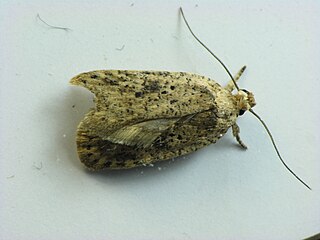Agonopterix antennariella is a moth in the family Depressariidae. It was described by John Frederick Gates Clarke in 1941. It is found in Washington, British Columbia and western Greenland.
Agonopterix costimacula is a moth in the family Depressariidae. It was described by John Frederick Gates Clarke in 1941. The Global Lepidoptera Names Index lists it as a synonym of Agonopterix nigrinotella. It is found in North America, where it has been recorded from Maryland, Michigan, Ohio and Ontario.
Agonopterix dimorphella is a moth in the family Depressariidae. It was described by John Frederick Gates Clarke in 1941. It is found in North America, where it has been recorded from South Carolina, Illinois, Nebraska, Kansas and Arkansas.
Agonopterix fusciterminella is a moth in the family Depressariidae. It was described by John Frederick Gates Clarke in 1941. It is found in North America, where it has been recorded from California to southern British Columbia, as well as from North Carolina and Tennessee.
Agonopterix oregonensis is a moth in the family Depressariidae. It was described by John Frederick Gates Clarke in 1941. It is found in North America, where it has been recorded from California to southern British Columbia.
Agonopterix rosaciliella is a moth in the family Depressariidae. It was described by August Busck in 1904. It is found in North America, where it has been recorded from Alaska and western Saskatchewan through Washington to California and Arizona.
Agonopterix sanguinella is a moth in the family Depressariidae. It was described by August Busck in 1902. It is found in North America, where it has been recorded from Arizona, New Mexico and Nevada.

Agonopterix senicionella is a moth in the family Depressariidae. It was described by August Busck in 1902. It is found in North America, where it has been recorded from Kentucky, Michigan, Ohio, Virginia and West Virginia.
Agonopterix curvilineella, the curved-line agonopterix moth, is a moth in the family Depressariidae. It was described by William Beutenmüller in 1889. It is found in North America, where it has been recorded from Illinois, Indiana, Kentucky, Maine, Maryland, Massachusetts, Michigan, Minnesota, Mississippi, New Brunswick, New York, Ohio, Ontario, Quebec, Tennessee, West Virginia and Wisconsin.
Agonopterix latipalpella is a moth in the family Depressariidae. It was described by William Barnes and August Busck in 1920. It is found in North America, where it has been recorded from Texas.
Agonopterix pteleae is a moth in the family Depressariidae. It was described by William Barnes and August Busck in 1920. It is found in North America, where it has been recorded from Illinois, Michigan and Ohio.
Depressaria atrostrigella is a moth in the family Depressariidae. It was described by John Frederick Gates Clarke in 1941. It is found in North America, where it has been recorded from south-western Manitoba and Colorado.
Depressaria eleanorae is a moth in the family Depressariidae. It was described by John Frederick Gates Clarke in 1941. It is found in North America, where it has been recorded from Alberta, Ontario and in Maine.
Depressaria palousella is a moth in the family Depressariidae. It was described by John Frederick Gates Clarke in 1941. It is found in North America, where it has been recorded from Washington.
Depressaria yakimae is a moth in the family Depressariidae. It was described by John Frederick Gates Clarke in 1941. It is found in North America, where it has been recorded from Washington.
Exaeretia hildaella is a moth in the family Depressariidae. It was described by John Frederick Gates Clarke in 1941. It is found in North America, where it has been recorded from Alberta and the Northwest Territories.

Eucosma abstemia is a species of moth of the family Tortricidae first described by Edward Meyrick in 1932. It is found in the United States, where it has been recorded from Colorado, Arizona and California.
Muna zostera is a moth in the family Depressariidae, and the only species in the genus Muna. Both the genus and species were described by John Frederick Gates Clarke in 1978. It is found in Chile.
Perzelia is a monotypic moth genus in the family Depressariidae. Its only species, Perzelia arda, is found in Chile. Both the genus and species were described by John Frederick Gates Clarke in 1978.
Eraina thamnocephala is a species of moth in the family Oecophoridae erected by John Frederick Gates Clarke in 1978. It is found in Chile.

